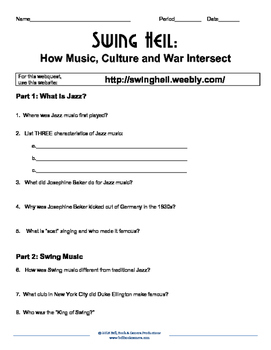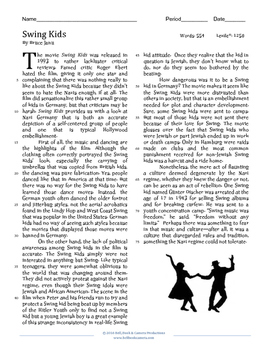Swing Heil: Jazz, Swing Kids and Nazi Culture--A Mini Unit
- Zip
- Webquests
Description
In the 1930s, Swing music was all the rage. And a small group of devoted teenagers in Nazi Germany challenged the regime simply by the music they listened to. This mini-unit is perfect for a high school world history course and a viewing of the 1993 film, "Swing Kids." This package contains 4 activities:
1. Swing Heil: How Music, Culture and War Intersect Webquest. This webquest is 6 pages of exploration of jazz and swing music, the Hitler Youth and the historical Swing kids. The webquest focuses on vocabulary building and picture interpretation. Students will also have to decipher Swing-era slang. The website for the webquest was specifically designed for this activity and is a great way to introduce students to the subject before viewing the movie, Swing Kids.
2. Swing Kids Viewing Guide. This sheet the students fill out while viewing the movie, Swing Kids. The focus is on vocabulary, plot and pulling evidence from the film to argue a prompt about life in Nazi Germany.
3. Swing Kids Quiz. This is a 24 question quiz that tests student knowledge from the film and the webquest.
4. Swing Kids ACT-Style Reading. This 554 word reading examines the historical accuracy of the movie and has 10 ACT/SAT style questions based on the reading. The reading is at a Lexile Score of 1250.
Answer keys are included with all of the activities.
Note: This product has been updated due to an error in one of the pdf files.





